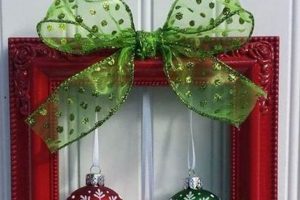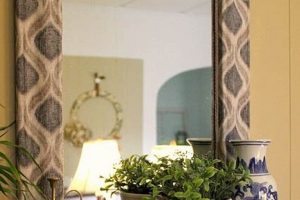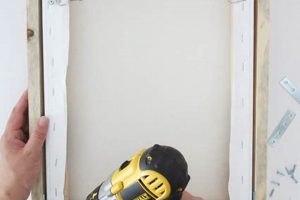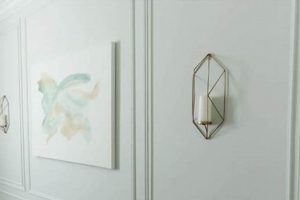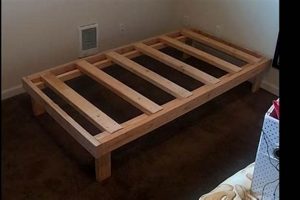The construction of a self-assembled, A-shaped support structure for climbing plants offers a customizable solution for gardeners. This type of support allows for vertical plant growth, maximizing space utilization and enhancing aesthetic appeal. For example, using readily available lumber and basic tools, one can create a durable and visually pleasing structure tailored to specific plant varieties and garden dimensions.
Implementing vertical gardening techniques, such as with plant supports, presents several advantages. These include improved air circulation around plants, reduced susceptibility to ground-borne diseases, and easier harvesting. Historically, similar frameworks have been employed to optimize agricultural yields and manage plant growth in both domestic and commercial settings. The practice contributes to sustainable gardening by encouraging efficient resource utilization and minimizing the need for extensive ground cultivation.
The following sections will detail the materials required, step-by-step construction process, design considerations, and maintenance practices necessary for creating and maintaining a long-lasting and effective plant support system. This guide aims to provide the information needed to successfully build a vertical structure that enhances both the functionality and beauty of a garden.
Construction Considerations
The following recommendations aim to improve the longevity and functionality of self-assembled plant support structures.
Tip 1: Material Selection. Opt for weather-resistant lumber, such as cedar or treated pine, to mitigate rot and decay. The selected materials should be capable of withstanding the elements and the weight of mature plants.
Tip 2: Accurate Measurements. Prior to cutting any lumber, verify all measurements to ensure structural integrity and desired dimensions. Precise construction ensures stability and aesthetic consistency.
Tip 3: Secure Fasteners. Use exterior-grade screws or bolts to assemble the frame. Nails may loosen over time due to weather exposure and plant weight. Reinforce joints with metal brackets for added stability.
Tip 4: Angle Consistency. Maintain a consistent angle for the A-frame to ensure equal weight distribution and prevent leaning. A protractor or angle finder can aid in achieving uniformity.
Tip 5: Soil Anchoring. Secure the structure into the ground using metal stakes or ground anchors. This prevents the structure from tipping over due to wind or plant growth.
Tip 6: Surface Treatment. Apply a protective sealant or paint to the finished structure to further protect the wood from moisture and UV damage. Reapply periodically as needed.
Tip 7: Consider Plant Weight. Design the structure with the mature weight of the intended plants in mind. Reinforce the frame as needed to accommodate heavier species.
Adhering to these guidelines ensures the construction of a durable and effective plant support system, contributing to the overall health and aesthetics of the garden.
These suggestions provide a solid foundation for successful construction. The subsequent sections will explore customization options and advanced building techniques.
1. Structural Integrity
The inherent stability and load-bearing capacity define the structural integrity of an A-frame plant support. Within the context of an A-frame construction, this signifies its ability to withstand external forces such as wind, plant weight, and environmental factors without deformation or collapse. The selection of materials directly impacts this integrity; using subpar lumber or inadequate fasteners can lead to premature failure, particularly under the weight of mature climbing plants. For example, constructing a tomato support structure with untreated pine might result in rot and eventual collapse within a single growing season, negating the purpose of the support entirely. Securing the base of the A-frame to the ground through anchoring techniques is also paramount.
Adequate structural integrity also influences the plant’s health and growth. A stable support prevents unnecessary stress on the plant’s stems and root system, promoting healthier development and maximizing yield. In contrast, a compromised structure can cause the plant to lean or fall, potentially damaging stems and disrupting nutrient uptake. Further, a well-designed and structurally sound frame allows even weight distribution, providing a more even surface for climbing and fruiting. This facilitates better air circulation and sunlight exposure. This contrasts to poorly-designed structures that might expose leaves and fruit disproportionately, increasing susceptibility to diseases.
In summary, structural integrity is a non-negotiable component when constructing a reliable A-frame plant support. It is directly related to the long-term success and benefit of the structure, ensuring both the health of the plants and the stability of the support itself. Compromising structural integrity to save resources will ultimately lead to failure and render the plant support ineffective. Planning and carefully selecting materials are crucial to achieve the proper A-frame structure.
2. Material durability
The longevity and performance of an A-frame plant support are intrinsically linked to the durability of the materials employed in its construction. Material durability dictates the structure’s capacity to withstand degradation caused by environmental factors, biological activity, and mechanical stress. An inadequate consideration of material durability during the construction phase can lead to premature failure, rendering the structure ineffective and potentially harming the supported plants. For example, using untreated softwood in a humid climate will result in rapid decomposition due to fungal growth and insect infestation. This necessitates frequent repairs or complete replacement, increasing both material costs and labor.
The choice of material influences the A-frame’s capacity to resist weathering, including prolonged exposure to sunlight, rain, and temperature fluctuations. Lumber with inherent resistance to decay, such as cedar or redwood, or pressure-treated wood, provides a significantly longer service life compared to untreated alternatives. Similarly, fasteners must be selected for their resistance to corrosion. Using galvanized or stainless-steel screws and bolts minimizes the risk of rust and ensures the structural integrity of the joints over time. The implications of inadequate material choices extend beyond simple replacement costs. A collapsing support can damage plants, disrupt garden aesthetics, and potentially pose a safety hazard.
In summary, material durability is a critical determinant of the overall value and effectiveness of an A-frame plant support. Investing in durable materials is an investment in the structure’s longevity and the health of the supported plants. The selection process should consider the local climate, the weight and growth habits of the intended plants, and the long-term maintenance requirements of the materials. By prioritizing material durability, constructors can ensure that the A-frame remains a functional and aesthetically pleasing element of the garden for years to come.
3. Dimensional Accuracy
Dimensional accuracy is a paramount consideration in the self-construction of A-frame plant supports. Precise measurements and adherence to design specifications directly influence the structural integrity, stability, and overall aesthetic of the finished product. Deviations from intended dimensions can compromise the support’s functionality and potentially lead to premature failure.
- Load Distribution and Stability
Accurate dimensions ensure balanced load distribution across the A-frame structure. Consistent leg lengths and precise angles are critical for maintaining equilibrium, particularly when supporting heavy or mature plants. Inconsistent dimensions can cause uneven weight distribution, leading to stress on specific joints and a potential risk of collapse. For instance, an A-frame with legs of unequal length will tend to lean, placing undue stress on the shorter leg and compromising overall stability.
- Joint Integrity and Fastener Effectiveness
Dimensional accuracy is essential for ensuring proper fit and secure connections at all joints. When lumber pieces are cut to precise lengths and angles, fasteners can engage fully and effectively. Gaps or misalignments resulting from inaccurate cuts can weaken the joints, reducing the overall strength of the A-frame. Inaccurate dimensions can cause screws and bolts to strip or shear under load, compromising the structural integrity.
- Visual Harmony and Aesthetic Integration
Accurate dimensions contribute significantly to the visual appeal of the A-frame plant support. Consistent measurements ensure uniformity and a professional finish, allowing the structure to blend seamlessly with the surrounding garden environment. Irregular dimensions can create an unsightly appearance, detracting from the aesthetic value of the garden. For example, legs of inconsistent lengths or an asymmetrical A-frame angle can create a visually jarring effect.
- Efficient Material Utilization
Precise measurements minimize material waste during the construction process. Accurate cuts reduce the need for corrections and adjustments, optimizing lumber usage and reducing the overall cost of the project. Inaccurate dimensions can lead to excessive scrap, increasing material expenses and potentially delaying completion. Furthermore, careful dimensioning allows for planned reuse of offcuts, contributing to a more sustainable building practice.
In conclusion, dimensional accuracy is not merely a cosmetic concern but a fundamental aspect of A-frame plant support construction. The aforementioned factors highlight the critical role precise measurements play in ensuring the structure’s stability, longevity, aesthetic appeal, and efficient resource utilization. Diligence in adhering to design specifications and employing accurate measuring techniques is essential for achieving a successful and functional plant support.
4. Assembly technique
The methods employed to assemble an A-frame plant support directly influence its structural integrity, longevity, and overall effectiveness. Proper execution of assembly techniques is critical to ensure the support functions as intended, providing reliable support for climbing plants while withstanding environmental stressors.
- Joint Construction
The manner in which the components are joined together dictates the strength and stability of the A-frame. Utilizing appropriate joinery techniques, such as mortise and tenon, lap joints, or butt joints reinforced with metal brackets, is essential. The selection of joint type should be based on the expected load and environmental conditions. For example, a simple butt joint secured with screws may suffice for a lightweight vine, while a heavier plant, such as a mature grapevine, requires more robust joinery to prevent failure under strain.
- Fastener Selection and Application
The choice of fasteners, including screws, bolts, nails, and adhesives, directly impacts the durability and longevity of the assembled structure. Exterior-grade fasteners, resistant to corrosion and weathering, are crucial for preventing premature deterioration. Proper application techniques, such as pre-drilling pilot holes to prevent wood splitting and ensuring fasteners are tightened securely, are equally important. The use of inappropriate fasteners or improper application can compromise the integrity of the joints, leading to structural instability.
- Alignment and Squareness
Maintaining accurate alignment and squareness throughout the assembly process is vital for ensuring stability and aesthetic appeal. The A-frame structure must be square and plumb to distribute weight evenly and prevent leaning or twisting. The use of levels, squares, and measuring tapes is essential for achieving accurate alignment. Deviations from squareness can compromise the structural integrity and create a visually unappealing structure.
- Surface Treatment Application
The application of protective coatings, such as paint, stain, or sealant, to the assembled structure provides a barrier against moisture, UV radiation, and biological degradation. Proper surface preparation, including cleaning and sanding, is critical for ensuring optimal adhesion and performance of the coating. The selection of appropriate coatings, specifically designed for exterior use, is essential for maximizing protection and extending the lifespan of the A-frame. Inadequate surface treatment can lead to premature decay and structural weakening.
The assembly technique is not merely a series of mechanical steps but rather a critical process that determines the long-term success of an A-frame plant support. The proper selection of materials, combined with meticulous execution of joining, fastening, aligning, and surface treatment methods, is essential for creating a functional, durable, and aesthetically pleasing structure. The attention to detail during the assembly process ensures that the plant support fulfills its intended purpose, providing reliable support for climbing plants while enhancing the garden environment.
5. Soil anchorage
Soil anchorage represents a critical, yet often overlooked, aspect of constructing A-frame plant supports. Securely anchoring the base of the structure to the ground ensures stability, preventing tipping or displacement due to wind, plant weight, or external forces. Without adequate soil anchorage, the effectiveness of the support is significantly compromised, potentially leading to plant damage and structural failure.
- Wind Resistance
An A-frame trellis, especially when laden with foliage, presents a substantial surface area to the wind. Soil anchorage provides the necessary resistance to counteract wind forces, preventing the structure from toppling over. The depth and type of anchoring method employed must be sufficient to withstand the prevailing wind conditions in the specific location. Insufficient anchorage can result in the entire structure being uprooted, causing damage to the plants and potentially posing a safety hazard.
- Plant Weight Stability
As climbing plants mature, their weight can exert considerable force on the A-frame support. Soil anchorage counterbalances this weight, preventing the structure from sinking into the ground or shifting position. The type of soil and its moisture content influence the effectiveness of anchorage. Loose or saturated soil requires deeper and more robust anchoring methods to ensure stability. Without it, an A-frame could start leaning, or collapsing.
- Structural Longevity
Proper soil anchorage contributes to the overall longevity of the A-frame trellis by minimizing stress on the joints and frame. By preventing movement and displacement, anchorage reduces the risk of structural fatigue and premature failure. Stable anchoring preserves the alignment and integrity of the A-frame, ensuring it continues to provide reliable support for climbing plants over extended periods. When neglected the whole A-frame structure longevity declines and becomes less durable.
- Mitigation of External Forces
Soil anchorage provides a buffer against accidental impacts or external forces that could destabilize the A-frame trellis. Anchored structures are less susceptible to being knocked over by animals, equipment, or human activity. This added level of security protects the plants and prevents potential damage to the support structure itself. For example, if someone bumps into an anchored A-frame it will resist that force better.
These considerations underscore the essential role soil anchorage plays in the successful implementation of an A-frame plant support strategy. Integrating appropriate anchoring techniques into the construction process is crucial for ensuring the structure’s stability, longevity, and effectiveness in supporting healthy plant growth. Lack of attention to the aspect of the anchorage of A-frame to the soil causes significant damage and safety hazards.
6. Plant suitability
The selection of climbing plant species for use in conjunction with a self-constructed A-frame support structure is a crucial determinant of both the support’s structural requirements and the plant’s overall health and productivity. Matching the plant’s growth habit, weight, and environmental needs to the A-frame’s design ensures a functional and aesthetically pleasing outcome.
- Weight and Load Capacity
The mature weight of the chosen plant directly impacts the necessary strength and stability of the A-frame structure. Selecting a plant species that exceeds the support’s load-bearing capacity can result in structural failure, potentially damaging the plant and requiring costly repairs. For example, a lightweight A-frame designed for annual vines may not be suitable for supporting a mature wisteria, which can exert significant force.
- Growth Habit and Climbing Mechanism
Different climbing plants employ diverse methods for ascending vertical structures. Understanding the plant’s climbing mechanism, such as twining stems, tendrils, or adhesive pads, is essential for selecting an A-frame design that facilitates effective growth. For instance, plants with tendrils require a trellis with small openings for the tendrils to grasp, while plants with twining stems require vertical supports to spiral around.
- Sunlight and Environmental Requirements
The A-frame’s placement and orientation must align with the selected plant’s sunlight requirements. Ensuring adequate sunlight exposure promotes healthy growth, flowering, and fruiting. Additionally, the A-frame’s materials and design should be compatible with the plant’s environmental needs, such as drainage and air circulation. An A-frame constructed from dark materials can overheat in full sun, potentially harming heat-sensitive plants.
- Maintenance and Pruning Considerations
The growth rate and pruning requirements of the selected plant should be considered when designing and constructing the A-frame. Choosing a plant that requires minimal pruning reduces maintenance efforts. Designing the A-frame to allow for easy access to the plant for pruning and harvesting is also beneficial. For example, a densely covered A-frame may be difficult to prune effectively, potentially leading to overcrowding and reduced productivity.
In conclusion, aligning plant species with a constructed A-frame support structure necessitates careful consideration of various factors, including weight, growth habit, environmental needs, and maintenance requirements. A well-matched plant-A-frame combination optimizes the plant’s health and productivity while ensuring the structure’s long-term stability and aesthetic integration within the garden setting. Disregard of these criteria ultimately undermines the project’s success.
Frequently Asked Questions
The following addresses common inquiries regarding the construction, implementation, and maintenance of self-assembled A-frame structures for supporting climbing plants.
Question 1: What is the optimal angle for an A-frame plant support?
The ideal angle for an A-frame varies depending on the specific plant species and desired aesthetic. However, a general range of 30 to 60 degrees from the horizontal plane provides a balance between stability and surface area for plant growth. Steeper angles offer greater stability but reduce the available climbing space, while shallower angles increase the climbing area but may compromise stability, especially in windy conditions.
Question 2: What is the best method for protecting the wood from rot and insect damage?
Protecting the lumber from environmental degradation is crucial for extending the lifespan of the A-frame. Utilizing naturally rot-resistant wood species such as cedar or redwood is recommended. Pressure-treated lumber provides an alternative, but requires careful consideration of potential chemical leaching. Applying a high-quality exterior wood sealant or paint provides an additional layer of protection against moisture and insect infestation. Reapplication should occur periodically based on the products instructions and environmental conditions.
Question 3: How deep should the A-frame be anchored into the ground?
The depth of soil anchorage depends on the A-frame’s size, the plant’s weight, and local wind conditions. As a general guideline, anchoring the A-frame legs at least 12 to 18 inches into the ground provides adequate stability in most situations. Utilizing metal stakes or ground anchors further enhances stability, particularly in loose or sandy soils. Periodic inspection of the anchors is recommended to ensure they remain secure.
Question 4: What type of fasteners is recommended for assembling an A-frame plant support?
Exterior-grade screws or bolts are preferred over nails for assembling an A-frame. Screws and bolts provide a stronger and more durable connection, resisting loosening due to weather exposure and plant weight. Galvanized or stainless-steel fasteners are recommended to prevent corrosion and ensure long-term structural integrity. Pilot holes should be pre-drilled to prevent wood splitting during assembly.
Question 5: How can the A-frame be customized to accommodate different plant species?
A-frame plant supports can be customized to accommodate various plant species by adjusting the dimensions, spacing of support elements, and overall design. Taller structures are suitable for vigorous climbers, while shorter, wider structures are better suited for bushier plants. Adjusting the spacing of horizontal supports allows for optimal growth and climbing based on the plant’s specific growth habit. Adding additional features, such as netting or wires, further enhances support for specific plant types.
Question 6: Is it necessary to disassemble the A-frame during the winter months?
Disassembling the A-frame during winter is generally not necessary, particularly if constructed from durable materials and properly anchored. However, removing dead plant material and inspecting the structure for damage is recommended. In regions with heavy snowfall, reinforcing the A-frame or temporarily removing it can prevent damage from excessive snow loads. Proper storage prevents unnecessary weathering.
These answers offer guidance on constructing and maintaining an A-frame plant support. Implementing these suggestions is crucial to ensure longevity and efficacy of the structure.
The subsequent section will address advanced design considerations.
Conclusion
The preceding exploration of A-frame plant support construction emphasizes the importance of considering structural integrity, material durability, dimensional accuracy, assembly technique, soil anchorage, and plant suitability. Each element contributes significantly to the longevity, stability, and overall effectiveness of the structure. Sound construction techniques paired with appropriate materials guarantee a robust support system for climbing plants.
Successful implementation of plant support structures improves garden aesthetics while also maximizing space utilization and promoting healthy plant growth. Therefore, diligent application of the presented construction and maintenance guidelines will yield a functional and visually appealing gardening solution. Attention to the elements discussed will yield sustainable growth and contribute to the long-term productivity of the garden.


![Build a Strong DIY Boxing Bag Frame [Project Guide] The DIY Hub: Creative Crafts, Repairs & Life Hacks Build a Strong DIY Boxing Bag Frame [Project Guide] | The DIY Hub: Creative Crafts, Repairs & Life Hacks](https://craftingdiycenter.com/wp-content/uploads/2025/07/th-2040-300x200.jpg)
